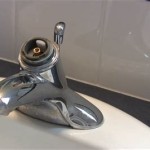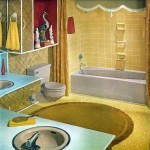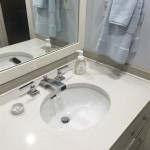Best Ways to Redo Bathroom Countertops
Bathroom countertops, often a focal point in the space, can significantly impact the overall aesthetic and functionality of a bathroom. Over time, countertops can become worn, stained, or simply outdated, prompting homeowners to consider a renovation. Selecting the best method for redoing bathroom countertops involves considering factors such as budget, desired aesthetic, durability requirements, and the existing countertop material.
Many options exist, ranging from simple refinishing techniques to full replacement with new materials. Each approach has its own set of advantages and disadvantages, making careful evaluation crucial to ensure the chosen method aligns with the homeowner's specific needs and preferences. This article will explore several of the most effective ways to redo bathroom countertops, highlighting the materials, techniques, and considerations involved in each process.
Refinishing Existing Countertops
Refinishing is a viable option for countertops that are structurally sound but aesthetically lacking. This process typically involves cleaning, repairing any minor damage, and applying a new coating to the existing surface. Refinishing is generally a more cost-effective solution than replacement, making it attractive for budget-conscious homeowners. The materials used for refinishing vary depending on the original countertop material.
For laminate countertops, refinishing kits are available that include a bonding agent, primer, and topcoat. These kits are designed to create a durable, water-resistant finish. The application process typically involves thorough cleaning, sanding to create a rough surface for adhesion, applying the bonding agent and primer, and then applying two or more coats of the topcoat. It is essential to follow the manufacturer's instructions carefully to ensure a successful outcome. The choice of topcoat is important, as some are more resistant to scratches and stains than others.
Solid surface countertops, such as Corian, can also be refinished. This process often involves sanding down the surface to remove scratches and stains, followed by polishing to restore the original shine. For deeper scratches or damage, a professional may be required to fill in the imperfections before sanding and polishing. The tools and techniques used for refinishing solid surface countertops are similar to those used for refinishing natural stone, but the specific products and procedures may vary.
Tile countertops, while less common, can also be refinished. This typically involves cleaning the grout lines, repairing any cracked or missing tiles, and then applying a sealant to protect the surface from water damage. Epoxy grout can also be used to update the appearance of the grout lines and provide a more durable, water-resistant surface. While refinishing can improve the appearance of a tile countertop, it is often more difficult to achieve a seamless, modern look compared to other countertop materials.
Overlaying Existing Countertops
Overlaying existing countertops involves covering the existing surface with a new material. This approach offers a way to update the look of the countertop without the expense and effort of removing the old one. Several materials are suitable for overlaying, each with its own set of characteristics and installation requirements.
One popular overlay option is epoxy resin. Epoxy resin can be poured over the existing countertop to create a smooth, seamless surface. The resin can be tinted to any color and can also be mixed with pigments, glitter, or other decorative elements to create a custom design. Epoxy countertops are durable, water-resistant, and relatively easy to clean. However, the installation process requires careful preparation and attention to detail to ensure a level, bubble-free finish. It's often recommended that this is done by a professional.
Another overlay option is concrete. Concrete overlays can be applied to existing countertops to create a modern, industrial look. The concrete can be tinted and textured to achieve a variety of different styles. Concrete countertops are durable and heat-resistant, but they can also be porous and require regular sealing to prevent staining. The application process involves applying a thin layer of concrete over the existing countertop, followed by sanding, polishing, and sealing.
Tile can also be used as an overlay material. New tiles can be installed directly over the existing countertop, creating a fresh, updated look. This option allows for a wide range of design possibilities, as tiles are available in a variety of colors, sizes, and patterns. When using tiles as an overlay, it is important to ensure that the existing countertop is level and structurally sound. Proper installation techniques, including the use of thin-set mortar and grout, are essential to create a durable, water-resistant surface.
Replacing Countertops with New Materials
Replacing existing countertops with new materials is the most extensive and often the most expensive option. However, it offers the opportunity to completely transform the look and feel of the bathroom. Various materials are available for bathroom countertops, each with its own unique advantages and disadvantages. The choice of material should be based on factors such as budget, durability, aesthetic preferences, and maintenance requirements.
Granite is a popular choice for bathroom countertops due to its durability, heat resistance, and natural beauty. Granite is available in a wide range of colors and patterns, making it easy to find a style that complements the bathroom's decor. Granite countertops require sealing to prevent staining and are relatively expensive compared to other countertop materials. The installation process typically requires professional assistance due to the weight and complexity of the material.
Quartz is another popular option for bathroom countertops. Quartz is a manufactured stone product that combines natural quartz crystals with resins and pigments. Quartz countertops are durable, non-porous, and resistant to scratches and stains. They are also available in a wide range of colors and patterns, including options that mimic the look of natural stone. Quartz countertops are generally more expensive than laminate but less expensive than granite. Installation typically requires professional assistance.
Laminate is a cost-effective option for bathroom countertops. Laminate countertops are made from layers of paper and resin bonded to a particleboard core. Laminate is available in a wide range of colors and patterns, including options that mimic the look of natural stone and wood. Laminate countertops are relatively easy to install and maintain, but they are less durable than granite or quartz and can be susceptible to scratches and water damage. Laminate is a good choice for budget-conscious homeowners who are looking for a stylish and functional countertop.
Solid surface countertops, such as Corian, are another option to consider. Solid surface countertops are made from a blend of minerals and resins. They are durable, non-porous, and seamless, making them easy to clean and resistant to stains. Solid surface countertops can also be molded into custom shapes and designs. However, they can be more susceptible to scratches and heat damage than granite or quartz. Installation typically requires professional assistance.
Other countertop materials to consider include marble, concrete, and wood. Marble is a luxurious and elegant option, but it is also porous and susceptible to staining. Concrete countertops offer a modern, industrial look, but they require regular sealing to prevent staining. Wood countertops add warmth and character to the bathroom, but they require careful maintenance to prevent water damage. The specific maintenance requirements of each material should be carefully considered before making a final decision.
Before proceeding with any countertop replacement project, it is important to carefully measure the existing countertop and plan the layout of the new countertop. This includes determining the location of the sink, faucet, and other fixtures. It is also important to consider the weight of the new countertop and ensure that the existing cabinets can support the weight. In some cases, it may be necessary to reinforce the cabinets to accommodate the new countertop. Obtaining professional advice from a contractor or designer can be helpful in ensuring a successful outcome.

Paint Bathroom Vanity Countertop Sink So Easy A Piece Of Rainbow
:strip_icc()/101922779-2cbc45e123c34827afb4f601723b03ca.jpg?strip=all)
How To Paint Bathroom Countertops

Paint Bathroom Vanity Countertop Sink So Easy A Piece Of Rainbow

5 Easy Ways To Declutter Your Bathroom Countertop

How To Paint A Bathroom Countertop Ace Hardware

Ways To Freshen Up Your Bathroom Countertop

Paint Bathroom Vanity Countertop Sink So Easy A Piece Of Rainbow

Bathroom Remodel Choosing A Counter Top Material Wd Smith

Diy Vanity Tops For Your Bathroom

7 Types Of Countertops For Bathrooms
Related Posts







